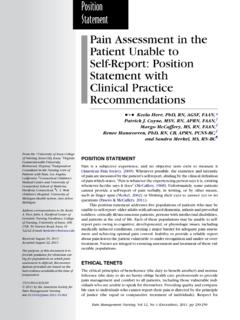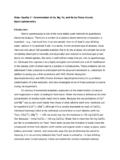Transcription of Guide To Preparation of Stock Standard Solutions
1 ChemiasftGuide To PreparationofStock Standard SolutionsFirst EditionMay 2011Na1000 ppm+ All Copyrights reserved to Chemiasoft 2004 2011, Page 2 of 61 Guide to Preparation of Stock Standard Solutions , First Edition Guide To Preparation Of Stock Standard Solutions By: CHEMIASOFT May 2011 Page 3 of 61 All Copyrights reserved to Chemiasoft 2004 2011, Guide to Preparation of Stock Standard Solutions , First Edition All Copyrights reserved to Chemiasoft 2004 2011, Page 4 of 61 Guide to Preparation of Stock Standard Solutions , First EditionTable of Content Forward .. 6 Who Should Read it? .. 7 Chapter 1: Introduction .. 8 Stock Standard Solution: .. 8 Scientific Notation .. 8 Significant Figures .. 8 Addition and Subtraction of Significant Figures .. 11 Multiplication and Division of Significant Figures .. 12 Mathematical Operation .. 13 Rounding Result.
2 14 Expressing Concentration of Solute: .. 15 Molarity and Formality .. 15 Normality .. 18 Molality .. 21 Weight, Volume, and Weight-to-Volume Ratios .. 22 Converting Between Concentration Units .. 24 Dilution of Concentrated Solutions .. 28 More Examples .. 30 Problems .. 35 Chapter 2: Types of Stock Standard Solutions .. 37 Introduction .. 37 Ionic Standard Solutions : .. 37 Ionic Compounds: .. 37 Element Standard Solutions : .. 43 Formula Standard Solutions : .. 46 Practical & Challenge Problems .. 47 Chapter 3: Laboratory Practical Guide .. 50 Introduction .. 50 Basic Laboratory Rules .. 50 General Rules .. 50 Personal Protection Rules .. 50 Hygiene Rules .. 51 Emergencies Rules .. 51 Storage and Disposal Rules .. 51 Page 5 of 61 All Copyrights reserved to Chemiasoft 2004 2011, Guide to Preparation of Stock Standard Solutions , First Basic Equipment and Instrumentation .. 51 Instrumentation for Measuring Mass.
3 51 Equipment for Measuring Volume .. 53 Preparing Solutions .. 55 Labeling and storing Solutions .. 57 Checklist for preparing Solutions of known concentration .. 58 Laboratory Note Book .. 59 References .. 61 All Copyrights reserved to Chemiasoft 2004 2011, Page 6 of 61 Guide to Preparation of Stock Standard Solutions , First EditionForward We are looking to make chemistry simple, easy for student, teacher, chemist, analyst and scientist. We are trying our best starting from small principles in chemistry. We found some chemists are making some mistakes in calculation. This simple book is a practical training for chemist, technicians or scientist for Solutions calculations. Page 7 of 61 All Copyrights reserved to Chemiasoft 2004 2011, Guide to Preparation of Stock Standard Solutions , First EditionWho Should Read it? This help book is written to be readable by anyone who has idea in basic principles of general chemistry.
4 It will help student, teachers, chemist, scientist and engineers .. etc who s working in chemistry field to fully understand the Preparation of Stock Standard solution. It will start from basic calculations up to practical Preparation procedure in lab. Chapter one is an introduction explain basic principles of calculations for concentration units and conversion between them. It also considers view examples in each section and general example at the end of chapter. Including a lot of examples in each chapter is to help readers to fulfill understand principles in the Preparation of Standard solution. Chapter two consider types of Stock standards depending on the formula types of analyte, because of different applications in lab and different methods used in analysis, some by ICP for metals, titration or Ion Chromatography for anions and cations and Formula standards for Preparation of reagents. Calculations for each type are slightly same but we make it in different sections to simplify the idea of Stock standards Preparation .
5 Because some chemists still can t distinguish between them. Chapter three include practical laboratory Guide . It is include some basic principles and Guide to work in lab for preparing Stock Standard solution. All Copyrights reserved to Chemiasoft 2004 2011, Guide to Preparation of Stock Standard Solutions , First EditionChapter 1: Introduction Stock Standard Solution: Analysis in any laboratory mainly based on reference materials like Stock Standard solution. The accuracy in the Preparation of Stock Standard reflects accuracy of the results. Stock Standard solution is defined as a solution with high concentration of stable analyte(s) that can be stored at specific conditions in laboratory for long time and used as a Standard reference material for analysis of the target analyte(s) in the daily use. Example of Stock Standard Solutions for like Sodium (Na) solution with a concentration of 1000 mg Na /L (ppm) used as Stock solution for Sodium analysis by Inductively Coupled Plasma (ICP), Flame Photometry, Ion Chromatography (IC).
6 Etc, that can be stored at 4 0C for a minimum of 6 months. All Stock standards shall be checked before use with another Standard that has been prepared separately from different source. To prepare Stock Standard solution in lab you should first make sure that you understand the concentration unit principles and some mathematical rules which will help to find exact answer for reporting. Scientific Notation Scientific notation is simply a method for expressing, and working with, very large or very small numbers. It is a short hand method for writing numbers, and an easy method for calculations. Numbers in scientific notation are made up of three parts: the coefficient, the base and the exponent. Scientific notation expression: n10N Where (1 < N < 10 ) Example number 2,890,000,000 becomes x 109 and expressed in scientific notation as 10-5 Good Practice: Express the following numbers in scientific notation: (a) (b) (c) 12, Significant Figures Every experiment (except in some counting situations) involves a degree of uncertainty.
7 Thus, suppose that several people measure the length of a sheet of paper, using a ruler that is divided into tenths of a centimeter, and get the following results: cm, cm, cm, cm. Notice that everyone Page 9 of 61 All Copyrights reserved to Chemiasoft 2004 2011, Guide to Preparation of Stock Standard Solutions , First Editionagrees as to the first three digits (except the last person who is measuring from the wrong end of a 30 cm long ruler!). Clearly the fourth digit, which has been estimated by everyone, is a doubtful figure (in fact even the third figure may be doubtful if the ruler is too short or too long due to manufacturing defect or environmental factors). Definition: The digits that are considered correct and the first doubtful digit are called significant figures. The number of significant figures in a measurement depends upon the precision of the instrument and, to some extent, upon the skill of the measurer.
8 An effort should always be made to obtain as many figures as an instrument will allow. Conversely, only significant figures should be recorded in taking data , a measurement should not be written in such a way as to imply a greater precision than is actually inherent in the measuring device and/or measuring technique. For example, if we weigh a sample on a balance and record its mass as g, we assume that all digits, except the last, are known exactly. We assume that the last digit has an uncertainty of at least 1, giving an absolute uncertainty of at least g, or a relative uncertainty of at least % 100 g g = Significant figures are a reflection of a measurement s uncertainty. The number of significant figures is equal to the number of digits in the measurement, with the exception that a zero (0) used to fix the location of a decimal point is not considered significant.
9 This definition can be ambiguous. For example, how many significant figures are in the number 100? If measured to the nearest hundred, then there is one significant figure. If measured to the nearest ten, however, then two significant figures are included. To avoid ambiguity we use scientific notation. Thus, 1 102 has one significant figure, whereas 102 has two significant figures. For measurements using logarithms, such as pH, the number of significant figures is equal to the number of digits to the right of the decimal, including all zeros. Digits to the left of the decimal are not included as significant figures since they only indicate the power of 10. A pH of , therefore, contains two significant figures. Exact numbers, such as the stoichiometric coefficients in a chemical formula or reaction, and unit conversion factors, have an infinite number of significant figures. A mole of CaCl2, for example, contains exactly two moles of chloride and one mole of calcium.
10 In the equality 1000 mL = 1 L both numbers have an infinite number of significant figures. All Copyrights reserved to Chemiasoft 2004 2011, Page 10 of 61 Chapter 1: IntroductionRecording a measurement to the correct number of significant figures is important because it tells others about how precisely you made your measurement. For example, suppose you weigh an object on a balance capable of measuring mass to the nearest mg, but record its mass as g instead of g. By failing to record the trailing zero, which is a significant figure, you suggest to others that the mass was determined using a balance capable of weighing to only the nearest 1 mg. Similarly, a buret with scale markings every mL can be read to the nearest mL. The digit in the hundredth s place is the least significant figure since we must estimate its value. Reporting a volume of mL implies that your buret s scale is more precise than it actually is, with divisions every mL.






